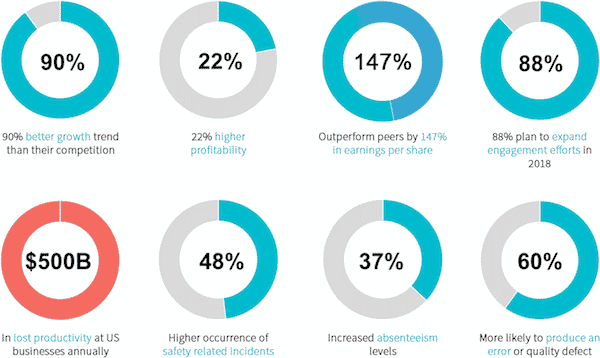With the ubiquity of digital communication tools in today’s workplace and the resultant demand to deliver more––and faster than ever before––the amount of time we spend in front of screens during our workday is growing. Consequently, with less face-to-face interaction it might not be as apparent if employees are struggling, particularly when it comes to remote or mobile workers who may not be interacting on a daily basis with management. Try as we might to individually mitigate the effects of anxiety, we can’t do it alone and need a comprehensive workplace wellness plan
Company Wellness Programs Examples: Productivity, Cost, and Employee Engagement
There are many factors that impact wellness when it comes to your workforce, but the data is clear. Workplace well-being directly impacts the following aspects of your organization:
- Employee engagement and investment
- Workforce productivity
- Workplace safety
- Frontline worker retention
- Absenteeism
- Profitability
Not investing in workforce wellness and engagement can result in substantial financial and personnel costs including losses in employee productivity, not to mention safety risks if team members aren’t able to adequately focus and perform. The top row of this chart represents statistics around engaged workforces, while the bottom highlights the negative effects of disengaged employees.
Fortunately, this can be avoided with proactive, management-led foresight and an open-door policy when it comes to confiding well-being issues. The success of your workforce wellness strategy relies on consistent programs that encourage sustained participation, and that are woven into the fabric of your organization’s internal communication strategy.
Implement Programs Based on Employee Feedback for a Corporate Wellness Plan Template
As a manager, the first step is to sit down with employees to go over what could be reasonably improved in the work environment to assess and address any issues. Examples of topics to cover include: the timing and frequency of breaks, break room amenities, or environmental conditions on the plant floor or where ever they spend the majority of their workday. This employee feedback can also be gathered using automated surveys on a team app.
In some cases, the issue may involve interpersonal dynamics with another coworker and require solutions that involve HR or more extensive actions. Regardless, determine an appropriate timeline for implementation and schedule follow-ups to check in on how the employee is doing and if any changes need to be made based on that feedback to the corporate wellness plan template.
Provide Opportunities for Workforce Wellness Programs
Many employers provide low to no-cost wellness plans or financial and points-based incentives for participating in one off-site at a local gym or as part of a fitness program. Other examples of workplace wellness ideas include having on-site workout facilities with workout equipment, or classes that employees can engage in before or after work hours, or on lunch breaks. Class offerings that focus on relaxation and mindfulness, such as yoga or other forms of meditation, are just some of the specific ways to incorporate physical activity into your workforce wellness program.
Another wellness option to consider adding is a group counseling plan to your employee benefits package. Encourage enrollment so your workforce is well-aware of this resource at their disposal. Using a team communication app like Beekeeper is an efficient way to share information like this in real-time with your workforce, and can be a valuable tool to track enrollment and participation in your workplace wellness program.








